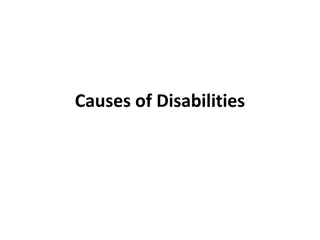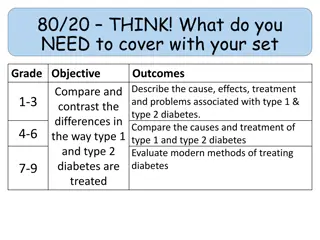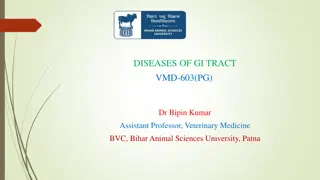Environmental Geography and Disaster Management
The causes, impacts, and management strategies for forest fires/wildfires. Learn about anthropogenic causes, natural causes like lightning, and the threat they pose to biodiversity and ecosystems.
2 views • 13 slides
Understanding Fatigue: Definitions, Causes, and Management
Fatigue is defined as an unpleasant symptom that affects an individual's normal functioning capacity. It can manifest as tiredness, weakness, or lack of energy. Common causes of fatigue include sleep loss, heavy physical or mental work, and chronic conditions like Chronic Fatigue Syndrome. The manag
3 views • 36 slides
Understanding Cybercrime: Causes, Definitions, and Consequences
Explore the world of cybercrime through discussions on its causes, definitions, and consequences. Discover the motives behind cybercriminal activities, learn about the various online crimes committed, and decipher the impacts of such actions. Delve into themed activities like cracking codes, idea sh
2 views • 16 slides
Causes of Disabilities Across Different Stages of Life
Disabilities can arise at various stages of life, including prenatal, perinatal, infancy, early childhood, adolescence, adulthood, and old age. The causes of disabilities can be categorized into prenatal, perinatal, and postnatal factors. Prenatal causes include genetic deformities, maternal health
0 views • 24 slides
Understanding Thickened Liquids in Dysphagia Management
Thickened liquids are often recommended for residents with swallowing difficulties to prevent aspiration pneumonia. Recommendations are typically made by speech pathologists, with nursing sometimes adjusting based on availability of therapy. Aspiration pneumonia occurs when substances are inhaled in
2 views • 33 slides
Understanding Stillbirth: Causes, Symptoms, and Investigations
Stillbirth, the delivery of a baby with no signs of life after 20 completed weeks of pregnancy, can have profound emotional and social effects. Unexplained causes account for 50% of cases, with fetal, placental, and maternal factors contributing. Risk factors include obesity, maternal age, smoking,
2 views • 26 slides
Understanding Photosensitization in Animals - Causes and Types
Photosensitization in animals is the activation of photodynamic chemicals on the skin by UV or visible light, leading to cellular damage and inflammation. Factors necessary for photosensitization include oxygen, sunlight, specific chemicals, and skin lacking pigments. Types of photosensitization inc
1 views • 8 slides
Understanding Diabetes: Type 1 vs. Type 2, Causes, Treatments, and Modern Methods
Explore the differences between type 1 and type 2 diabetes, including causes, effects, treatments, and associated problems. Compare the causes and treatments of both types of diabetes while evaluating modern methods of treatment. Understand the symptoms, lifestyle factors, and risk factors related t
0 views • 18 slides
UNICEF Conceptual Framework on the Causes of Malnutrition
The UNICEF conceptual framework on the causes of malnutrition outlines the multidimensional factors contributing to malnutrition, categorized into immediate, underlying, and basic causes. Immediate causes include inadequate dietary intake and diseases, while underlying causes involve issues like ina
2 views • 18 slides
Understanding Dysphagia in the ICU: Assessment and Impact
Dysphagia, the difficulty in swallowing, is a common issue in the ICU, affecting a significant percentage of intubated patients. It increases mortality, risk of pneumonia, malnutrition, and prolongs hospital stays. Assessment methods like bedside evaluation and FEES are crucial in managing dysphagia
5 views • 8 slides
Understanding Nephritis: Causes, Symptoms, and Subtypes
Nephritis is a serious medical condition characterized by inflammation of the nephrons in the kidneys. This inflammation can lead to various subtypes such as glomerulonephritis and interstitial nephritis, each with its own causes and symptoms. Common symptoms of nephritis include edema, changes in u
0 views • 26 slides
Comprehensive Guide to Barium Swallow Procedure
Barium swallow is a dedicated test to evaluate the pharynx, esophagus, and proximal stomach. It helps diagnose conditions like dysphagia, obstructions, and motility disorders. This guide covers the indications, contraindications, preparation, contrast agents used, and evaluation steps for the proced
0 views • 13 slides
Understanding Esophageal Diseases: Anatomy, Physiology, and Disorders
Explore the anatomy and physiology of the esophagus, learn about common esophageal disorders such as GERD, understand the symptoms, complications, and management of reflux disease, differentiate between oropharyngeal and esophageal dysphagia, and delve into the causes, symptoms, investigations, and
2 views • 16 slides
Understanding Achalasia: Therapeutic Approaches, Pathophysiology, and Clinical Manifestations
Achalasia is characterized by a failure of the lower esophageal sphincter to relax, leading to difficulty in swallowing and regurgitation. The exact cause is unknown, but autoimmune factors and chronic infections may play a role. Symptoms include dysphagia, chest pain, regurgitation, and weight loss
0 views • 59 slides
Veldfires in South Africa: Causes, Impacts, and Solutions
In this environmental awareness information session presentation, the focus is on veldfires in South Africa. The presentation covers event objectives, causes of veldfires, their impact, and solutions to combat climate change. It emphasizes the importance of identifying causes, understanding impacts,
1 views • 15 slides
Exploring the Existence of Causes in Nature and Human Understanding
The discussion delves into whether everything has a cause and if humans can comprehend all causes. It contrasts functional and formal approaches, questioning the universal expectation that phenomena have causes and if humans can identify them all. Various linguistic theories are referenced, emphasiz
0 views • 27 slides
Revisiting Davidson's Arguments on Actions, Reasons, and Causes
Over sixty years after the publication of Donald Davidson's seminal paper on Actions, Reasons, and Causes, there is ongoing debate about whether rationalization is a form of causal explanation. This article challenges Davidson's viewpoint and discusses the relation between reasons and actions, explo
0 views • 107 slides
Understanding Spinal Canal Stenosis: Causes, Symptoms, and Classification
Spinal canal stenosis is the abnormal narrowing of the spinal canal or intervertebral foramina, leading to compression of nerves and blood vessels. It can result in symptoms such as radiculopathy, claudication, myelopathy, and more. Cervical stenosis presents with arm pain and weakness, while lumbar
0 views • 18 slides
Understanding Cause Analysis in Problem Solving
Cause analysis, or CA, is a vital tool for investigating incidents, identifying underlying causes, and implementing corrective actions to prevent recurrence. By delving deep into the root causes of problems, CA enables organizations to make effective recommendations and address issues at their sourc
0 views • 12 slides
Understanding Causal Factors in Illness: Toxins, Smoking, and Contributing Causes
Causal standards for illness attribution, toxins' role in disease onset and expression, and the impact of factors like smoking and contributing causes on health outcomes are explored. The distinction between certain and contributing causes, as well as the level of certainty in carcinogen classificat
1 views • 19 slides
On-Orbit Anomaly Research at NASA: Causes and Solutions
On-Orbit Anomaly Research (OOAR) at NASA's IV&V Facility involves studying mishaps related to space missions, identifying anomalies, and improving IV&V processes. The research delves into the causes of anomalies, such as operating system faults, and proximate causes like software deficiencies. Detai
0 views • 20 slides
Understanding Maternal and Perinatal Death Surveillance and Response
Explore the causes and classification of maternal and perinatal deaths, emphasizing the importance of determining the primary, contributory, and final causes of death. Learn how to categorize maternal deaths according to ICD-MM and perinatal deaths according to ICD-PM classifications. Delve into the
0 views • 61 slides
Understanding Aristotle's Theory of the 4 Causes in Physics
Dig into Aristotle's theory of the 4 causes applied to inanimate objects, exploring the nature of something, the intellectual context regarding change, and the significance of causes in philosophical inquiry.
0 views • 18 slides
Assisting with Oral Feeding, Dysphagia Management, and Enteral Tube Feeding in Healthcare
This content covers essential aspects of assisting with oral feeding for individuals at risk for aspiration, managing dysphagia with specific recommendations and diet progression, and enteral tube feeding procedures and complications. It emphasizes safety, dignity, and independence in feeding practi
3 views • 12 slides
Assisting with Enteral Tube Feeding and Dysphagia Management
This content covers essential information on assisting with oral feeding for patients at risk of aspiration, managing dysphagia, diet progression, and enteral tube feeding procedures. It emphasizes safety, independence, and dignity in feeding practices. The content includes tips for preventing aspir
0 views • 12 slides
Managing Eating and Swallowing Challenges After Stroke
Dysphagia, a common issue after a stroke, can lead to difficulty swallowing and may require texture modifications in food and fluids for safety. Up to 65% of stroke survivors may experience dysphagia, which can lead to complications like pneumonia. Proper oral care, mealtime positioning, and awarene
0 views • 9 slides
Understanding Peptic Ulcers: Causes, Symptoms, and Treatment
Peptic ulcers are open sores that form in the stomach or upper small intestine, leading to symptoms like stomach pain, bloating, and nausea. Common causes include H. pylori infection and NSAID use. Recognizing symptoms, such as burning stomach pain, is crucial for timely diagnosis and management. Se
0 views • 19 slides
Understanding Thickened Fluids in Aged Care Facilities
Exploring the adequacy of thickened fluids in residential aged care settings, a study examined staff perceptions, preparation factors, adherence to IDDSI standards, and issues related to dysphagia. Findings revealed barriers, enablers, and the importance of staff education and support in ensuring th
0 views • 7 slides
Understanding Dementia and Speech Therapy by Vincent Delgiudice
Dementia impacts speech, swallowing abilities, and quality of life. Vincent Delgiudice, a certified SLP, offers therapy to enhance memory, communication, and safe swallowing strategies. Dysphagia in dementia needs evaluation for proper treatment. Learn about types of dementia symptoms and different
0 views • 19 slides
Understanding Hiatal Hernia and Irritable Bowel Syndrome (IBS) for Adult Nursing
A hiatal hernia involves the protrusion of the stomach through the diaphragm, leading to various types and complications. Symptoms may include heartburn and dysphagia, diagnosed through barium studies and endoscopic exams. Management includes lifestyle changes, medication, and surgical repair. Nursi
0 views • 15 slides
Understanding Chronic Sinusitis in Malaysia: Causes, Symptoms, and Treatment
Chronic sinusitis is a prevalent issue in Malaysia, affecting a significant portion of the population. This condition involves long-term inflammation of the sinuses, often recurring even after treatment. Common causes include allergies, inflammations, bone deformations, and sinus obstructions. Sympt
1 views • 11 slides
Understanding Dyspnea: Causes and Approach by Prof. Arvind Mishra, M.D.
Dyspnea, defined as breathing discomfort, can stem from respiratory or cardiovascular issues. Respiratory causes include airway diseases like asthma, pleural and lung diseases, and chest wall disorders. Meanwhile, cardiovascular causes involve left heart diseases, pulmonary vasculature issues, and p
2 views • 34 slides
Evidence-Based Practice in Critical Care: Focus on FEES in Dysphagia Management
This presentation outlines the activities of the Critical Care and Tracheostomy EBP Network in 2012, including a review of the year, changes in leadership, and discussions on the use of Fiberoptic Endoscopic Evaluation of Swallowing (FEES) in critical care settings. Various research articles are dis
0 views • 16 slides
Approach to Dysphagia: Esophageal Cancer & Achalasia Cases
This presentation covers the diagnostic approach and management strategies for dysphagia in a 65-year-old patient presenting with symptoms such as odynophagia, cough, hoarseness, and lymphadenopathy. It discusses the use of CBC, CXR, ECG, upper GI endoscopy, CT, and biopsy in assessing the location,
0 views • 38 slides
Comprehensive Overview of Medical Terminology in Gastrointestinal System
This content provides a detailed exploration of medical terminology related to the gastrointestinal system. It covers definitions, word roots, combining vowels, suffixes, and prefixes commonly used in this medical field. The material includes information on anatomical terms such as anus, appendix, c
0 views • 18 slides
Major Events and Causes of World War II
This content covers the major events and causes of World War II, detailing the timeline from the invasion of Poland to key declarations of war and military strategies employed. The causes are explored, including factors like the Treaty of Versailles, economic instability, fascist expansions, and the
0 views • 17 slides
Equine Gastrointestinal Tract Disorders and Dysphagia Overview
This informative content covers various diseases of the gastrointestinal tract in horses, including oral cavity conditions, dysphagia, sialadenitis, and esophageal disorders like choke. It discusses anatomical classifications, causes, clinical manifestations, and treatment approaches for these condi
0 views • 19 slides
Dysphagia Assessment & Yale Swallow Screen Post-Test Answers
Dysphagia assessment is crucial in identifying swallowing dysfunction. The post-test answers cover various aspects including definitions, statistics, patient management, and protocols like the Yale Swallow Screen. It emphasizes the importance of oral care, appropriate diet modifications, and when to
0 views • 12 slides
Review of Dysphagia Care for Parkinson's Patients in Hospital
A review was conducted on the quality of dysphagia care provided to patients with Parkinson's disease aged over 16 years who were admitted to the hospital when acutely unwell. Key findings include the importance of documenting swallow status in referral letters, screening patients for swallowing dif
0 views • 24 slides
Understanding Esophagus Anatomy, Physiology, and Diseases
Explore the anatomy and function of the esophagus, including its layers, innervation, and common disorders like dysphagia, motility disorders, strictures, and rings/webs. Learn about diagnostic methods such as barium swallow studies and endoscopy, as well as treatment options for conditions like ach
0 views • 18 slides







































